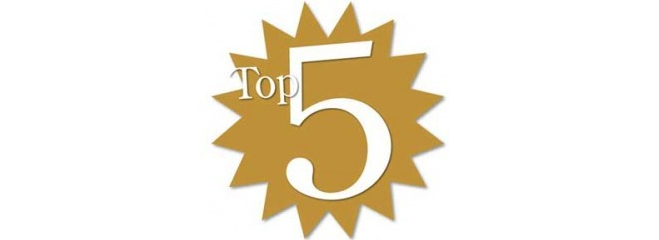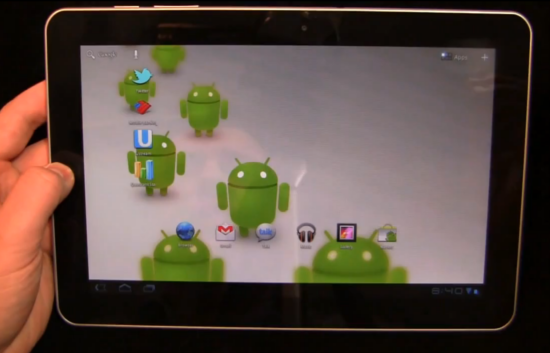
Many will argue to the grave that modern tablets are just a fad and have no place in the future. They are supplementary devices that offer slightly more usability than a smartphone but less functionality than a full-fledged PC. Regardless of their pending fate, they have proven over the past 14 months or so that they are currently a hot ticket item and in high demand. In fact, many retailers have had trouble keeping some tablet models in stock as they are selling out faster than they can be supplied.
Now that there are varying models available from numerous manufacturers, I am met with the question of how they stack up against one another. Fad or not, here are my top five tablets for the month of June:

Samsung's first attempt at the tablet market served as a probe for other Android tablet manufacturers. The original Galaxy Tab was undoubtedly a decent tablet, but running software that was intended for phones instead of tabs and carrying a fairly steep price tag (in comparison to other tablets at the time), it wasn't nearly as well received as Sammy was hoping. If you are in the market for a tablet, however, don't let the original Tab's reputation stop you from considering Samsung's latest iteration of the Tab line.
The Galaxy Tab 10.1 is the definition of what an Android tablet should be. Though its chassis are made primarily of plastic, the Galaxy Tab 10.1 has a super thin body (10.9mm) and feels great in the hand without being too heavy. It sports a 1GHz Tegra 2 dual-core processor, 8-megapixel rear shooter, and 16 or 32GB of internal memory. On top of stock Honeycomb, Samsung has implemented their TouchWiz UX interface which comes with a mini apps tray, extending multitasking to greater lengths. It is currently available in a WiFi-only model; 4G models are to follow in the coming months.
I was skeptical of ASUS at first. Their first attempt at a phone (Garmin Nüvifone) was a flop to say the least. However, their entry device in the tablet realm was a grand slam. Starting at $400 for the 16GB model, the Eee Pad Transformer comes at an extremely competitive price. With the addition of the $150 keyboard dock, the Transformer packs more functionality than all other current tablets.
In either a 16 or 32GB model, the Transformer comes with a Tegra 2 dual-core processor, 5-megapixel rear shooter and roughly 9-10 of battery life. Pairing the device with the keyboard dock, the battery life can be extended to up to 16 or more hours and it adds two full USB ports (that work with PS3 or 360 controllers and most other USB peripherals). If you are not looking to use a keyboard though, I would recommend considering other tablets, as the Transformer is hardly the best standalone device.
An iPad not residing at the top of my list is sure to spark a flame war of some sort. In truth, the iPad 2 was a pretty big letdown for customers and a prime example of planned obsolescence. Priced with the same structure as the original iPad and coming in many flavors, it's easy to pick an iPad that meets both your preferences and budget. With over 10,000 iPad specific applications and outstanding performance, the iPad 2 definitely isn't pulling its punches. It ships with Apple's A5 dual-core processor; 16, 32, or 64GB of memory; WiFi-only or in a 3G model; and it also comes with a choice of color (white or black).
The definite pitfall lies within its cameras. Consumers begged Apple for a tablet with cameras so they could use it for FaceTime. Apple responded by fitting the iPad 2 with bottom-of-the-bucket image sensors that are barely good enough for a low-quality video call. Poor cameras hardly make this tablet a drag though. It is still easily the best media consumption device available and most popular tablet out there.
Being the first high-quality Android tablet available, I feel compelled to include the Motorla XOOM. It is technically a Google device (think of it like a Nexus tablet) and supposed to offer the purest "Google experience" of any tablet. Equipped with most of the same specs as its Android tablet brethren, the XOOM is certainly a respectable device.
It ships with 3G capabilities on Verizon's network with the promise of a 4G upgrade in the not too distant future. The problem is, you will have to send the device off to Motorola – for up to a week – for them to install a 4G radio in the device. Also coming with a rather steep price tag. $800 for the 3G/4G model or $600 for a 32GB WiFi-only model, the XOOM easily loses out to its cheaper counterparts.

Oh, the BlackBerry PlayBook. Where do I begin? In all honesty, the PlayBook is a decent tablet. At 7-inches, it rubs the term "portability" in Apple and Android manufacturers' faces. Sporting a dual-core processor and a webOS-like interface, the PlayBook screams at multitasking. That said, the device is easily hindered by Bridge software and a small and slowly growing application support.
When the QNX tablet gets its update, it is rumored to support Android applications and will be equipped with native applications (Memopad, email, calendar, etc.), two features that could turn the tide for the BlackBerry tablet. Even though it isn't the sportiest tablet out there and definitely not the most loved, the PlayBook is still a decent machine and finds its place as the number five tablet on my list.